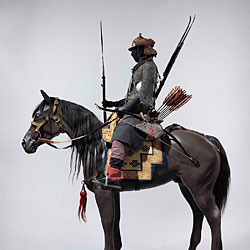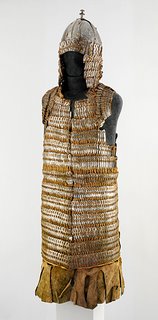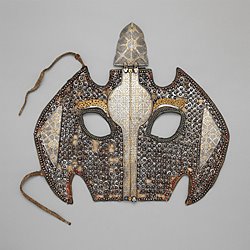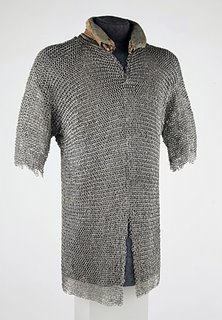
May 13, 2006
Arms and Armor From
Tibet at
the Metropolitan Museum
It's unusual to think of the Tibetans as warriors. This mostly Buddhist people, now ruled by China, is better known today as a deeply spiritual culture devoted to peace. But they were once fierce and, like others with turf to defend, held a vital stake in battles and weapons. Tibetan history includes long periods of heavy military activity, beginning in the seventh century. Tibet's early protector gods were worshiped as warriors, equipped with battle gear.
Tibetan skills in battle are made abundantly evident in "Warriors of the Himalayas: Rediscovering the Arms and Armor of Tibet" at the Metropolitan Museum of Art, a dazzling display of Tibetan war equipment from the 13th to 20th century. Replete with swords, saddles, guns, helmets and full body armor for man and horse, this group of some 130 objects reveals the multifarious Tibetan means of aggression and defense. And its handsome installation makes the comprehensive show all the more impressive.
Donald LaRocca, curator of the Met's department of arms and armor, organized the show and wrote most of its catalog, which includes an exceptional English-Tibetan glossary of arms and armor. He says that, surprisingly, many objects here were still being produced and used into the 20th century. That is explained by a sort of time lag between this remote plateau at the top of the world — an area roughly the size of Western Europe — and modern civilization. Many of the weapons were not outmoded by Tibetan standards.
Some older examples were kept for ceremonial use, particularly in the Great Prayer Festival held in Lhasa, Tibet's capital, at the start of each year. Votive weapons were also placed in monasteries and temples, housed in special chapels dedicated to Buddhism's guardian deities. But it has been possible, over the years, for the Met to build up its own collection, to which most of the objects on display belong.
Tibetan skill at bodily protection is most dramatically displayed in a life-size replica of a 15th- to 16th-century Tibetan or Mongolian cavalryman on his horse. Both are in full battle dress.
The warrior's three-quarter robe with elbow-length sleeves is made of lamellar body armor, a flexible, scale-like material thought to have been developed in the ancient Near East as early as the eighth century B.C. It consists of horizontal rows of small, overlapping plates of iron; unlike other small-plate armor, these are cleverly joined by leather lacing, with no lining or other support.
The horse wears one of the few surviving examples of full equine armor, made of iron lamellae augmented by panels of gilt and varnished leather. A face mask, or shaffron, is made of leather and covered with small, knob-studded iron plates sewn on by leather laces. The horse's neck is covered by two wing-shaped panels, covered with knobby plates like the ones on the shaffron.
Together, the man — who also wears a sword, helmet and shield — and horse are a strikingly invincible pair in their spectacular outfits, which faintly evoke those in your basic sword-and-sorcery movie.
A distinctive Tibetan look in the large array of helmets here evolved, perhaps, from one that dates to the 8th to 10th centuries. It is made of eight arched and overlapping plates, joined by leather laces and topped by a decorative finial meant to carry a plume. It is certainly an antecedent for a similar helmet dating to the 16th to 18th centuries, which was discovered in a dilapidated fort during a 1903 British invasion. The type seems to anticipate the Prussian helmet of latter-day German troops.
One oddball Mongolian iron helmet on view, dating from the 15th to 17th centuries, is of one piece, rising up in a high cone — closely resembling the oilcan headgear worn by the Tin Woodman in "The Wizard of Oz."
More flamboyant is the cavalry helmet, of one piece, with upturned fabric flaps; it is probably of Bhutanese origin but was adapted for use in Tibet. It is seen to smashing effect on another life-size replica of a cavalryman on horseback, assembled to represent 18th- to 19th-century military dress.
The helmet's bowl is topped by a finely chiseled and damascened (iron decorated with gold and silver) finial and sports an engraved and damascened iron brim. It is fitted with flaring neck and ear flaps made of a showy brocaded silk, probably from India. The horseman wears a mail shirt — different from lamellar armor in its alternating rows of riveted and solid rings — and carries a musket, a spear and a bow with a quiver of arrows, ready for all kinds of mayhem.
Tibetan artisans were capable of stellar work in metal, best seen here in the amazing decorations they produced for saddles. They were particularly adept at the pierced and chiseled metalwork that adorned the finest mounts, like a gorgeous set of saddle plates (about 1400) here — made of iron, gold, wood and semi-precious stones — that is said to represent a high point in the medium of pierced ironwork.
The seven plates, damascened overall with gold foil, are embellished with highly detailed dragons, writhing amid the intricate scroll patterning and punctuated by stone ornaments.
Superb metalwork is also seen in horse bridles, like one from the 15th to 17th century, in leather, iron and gold, that has an elaborate scheme of pierced and chiseled iron fittings damascened in gold. In the center of the forehead band, a plaque depicts a serpentine dragon on a scrollwork ground. Other adornments, including small animals, occur along the straps that hold the headstall on the horse's face.
So sumptuous is this bridle (owned by the Met but not acquired until 1998) that it was used on the horse ridden by Keanu Reeves in his portrayal of Prince Siddhartha, the founder of Buddhism, in the 1993 movie "Little Buddha."
There are so many other things to be admired here: elegantly jeweled swords and scabbards, magnificently damascened spears and muskets, beautifully decorated bows and arrow quivers. All qualify as beautiful objects, which paradoxically achieve aesthetic standing despite their being instruments of war.




No comments:
Post a Comment